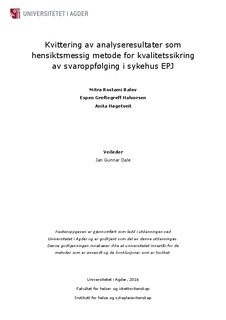| dc.contributor.author | Halvorsen, Espen Greftegreff | |
| dc.contributor.author | Høgetveit, Anita | |
| dc.contributor.author | Rostami Balov, Mitra | |
| dc.date.accessioned | 2016-09-28T08:41:24Z | |
| dc.date.available | 2016-09-28T08:41:24Z | |
| dc.date.issued | 2016 | |
| dc.identifier.uri | http://hdl.handle.net/11250/2411204 | |
| dc.description | Masteroppgave i helse- og sosialinformatikk- Universitetet i Agder, 2016 | nb_NO |
| dc.description.abstract | Background Laboratory results are essential in modern patient treatment, and follow up of test results is crucial to ensure the quality of patient care. Despite this more than 43 000 lab results were unsigned in the electronic healh record (EHR) at Oslo University Hospital (OUS) in April 2016. One of the main objectives of this study has been to identify the causes of missing signing of test results among physicians involved in patient treatment. Method A questionnaire was used for data collection from a selection of 585 physicians at OUS, of which 182 responded to the survey. Elements from the theory models Leawitt diamond and UTAUT were used to identify possible causation and contribute in analyzing a wide range of variables that may affect the signing of analysis results. Results Among the many reasons why physicians do not sign test results, the study reveals that the organization’s lack of focus on signing is of considerable importance. Other important elements are poor or unsufficient functionality in the journal system, and the fact that many of the signing tasks end up in an undefined worklist or they are missent to a wrong recipient. However, the main reason for neglecting signing seems to be lack of time. This becomes evident by the respondent’s desire for solutions for auto-signing or help from others to sign, faster computers and EHR, and time for the physician to accomplish signing tasks and follow up test results. Some physicians will not sign according to the intention, but only for appeasement of imposed requirements, giving an uncertain relationship between the signing and the follow-up of test results. Physicians affiliated to outpatient departments find signing more useful than physicians affiliated to inpatient departments. Conclusion Despite the challenges related to signing of test results, the study shows that the vast majority of physicians are relatively familiar with the intention of signing and that most analysis-results are signed. In consequence, signing of test results in EHR is considered to be an appropriate method for quality assurance of test-results follow up. | nb_NO |
| dc.language.iso | nob | nb_NO |
| dc.publisher | Universitetet i Agder ; University of Agder | nb_NO |
| dc.subject.classification | HSI500 | |
| dc.title | Kvittering av analyseresultater som hensiktsmessig metode for kvalitetssikring av svaroppfølging i sykehus EPJ | nb_NO |
| dc.type | Master thesis | nb_NO |
| dc.subject.nsi | VDP::Technology: 500::Information and communication technology: 550 | nb_NO |
| dc.source.pagenumber | [8], 82, 26 s. | nb_NO |
